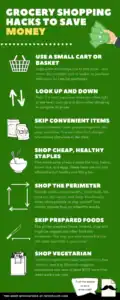By Marissa Valentine
Consumers across the United States can agree that the price of groceries has changed drastically over the last 30 years. Clevelanders and shoppers across Northeast Ohio often travel outside their communities for the most reasonable prices.
A recurring theme across social media and in news headlines is the increased price of eggs, dairy, and meat. As a patron of your local grocery store, it is imperative to know your options as you navigate budgeting your meals in an economy where prices continue to rise.
Rising Cost for the Middle Class
In 1986, the price of milk was $2.19; today, the cost of milk in Cleveland can range from $3.48 to $4.22 per gallon. As prices across all industries soar, Americans’ grocery bills do so yearly.
To depict how money is woven into the fabric of everything we do, as consumers, we must understand that not only has the cost of groceries increased, but so has the cost of living.
In 1988, the median household income was $25,872, which would equate to approximately $72,128.77 in 2025 according to the U.S. Bureau of Labor Statistics’ CPI Inflation Calculator.
The median income for Americans varies based on region, but according to Yahoo Finance, the middle-class median income range falls between $56,000 and $169,000.
If you fall on the lower end of the earning spectrum and have a larger family, groceries may be more expensive to manage than for those who earn on the higher end and have a smaller family.
Consumers across Northeast Ohio are struggling to keep up with rising grocery costs. “The cost of groceries has made a significant impact on my life,” said Cleveland native Ashley Mueller.
“As a single mom, I have to stick to a budget. I often take advantage of different company apps to compare prices and create an online cart to show me exactly how much I will be spending. Over the last four years, I’ve found myself switching from name-brand items to generic, bouncing between stores because of price differences, and having to sacrifice certain items because they do not fit within my budget.
As prices have increased lately, it has been even harder to keep up. I have a growing teenager, and we have to sit down together and prioritize what I am buying and ration what we eat to make it through until the next payday.”
Why Prices Continue to Rise
According to the US. Department of Agriculture (USDA), grocery prices have risen by approximately 28.2% since the start of the pandemic. Items that have most notably increased in price in 2024 were eggs due to an outbreak of avian flu.
As a result, customers have seen many wholesale stores, such as Costco and Sam’s Club, providing a robust offering of eggs, with a disclaimer limiting the number of cartons customers can purchase at one time.
The U.S. Labor Department’s Bureau of Labor Statistics (BLS) prices for food have steadily increased since 1968, so it is no surprise that Americans are paying more for groceries as the overall cost of living has increased.
However, in 2022 (post-COVID-19), as people returned to the office and restaurants started serving customers indoors, the rate of inflation reached an all-time high of 11.4%, the highest it has been since May of 1979.
Savvy Shopping: How to Reduce Costs
So the big question that many Americans are asking one another is, “How do we budget for groceries as prices show no sign of reduction?” In Cleveland, the monthly price of groceries for a family of four is approximately $1,444, according to Livingcost.org. The monthly price for groceries may seem high, but the average weekly cost is $361.
To help people offset the cost of groceries, there are discount stores that offer quality groceries at affordable prices:
Discount Stores -Stores like Aldi and Trader Joe’s offer healthy and organic meat, dairy, and dry goods that are often lower than larger competitors like Giant Eagle or Heinen’s.
Buying in Bulk -People have also purchased certain items in bulk from stores like Costco and compared grocery prices online to avoid overpaying for certain grocery items. Additionally, with drive-up grocery pickup available, customers who often pick up extra products that are not on their grocery list while in-store can avoid the extra add-ons by simply shopping online.
Reduced Food Apps -Lastly, there are apps like the Flashfood app that allow grocery stores to add produce that they deem unfit to sell or to be purchased in bulk at a reduced cost to customers.
What Now?
As grocery prices continue to rise, leaving Cleveland shoppers vulnerable to shifting their budgets to accommodate, community food banks and church food pantries can also be a great resource for those unable to make ends meet.
You can revamp your grocery list to shop and save by eating seasonal produce and buying discounted alternatives, which may help put more money in your pocket instead of on your grocery bill.
Marissa is a U.S. Navy veteran with more than a decade of journalism experience. She holds graduate and undergraduate degrees in communications and family therapy and enjoys writing and the arts
The Cleveland Observer remains committed to producing journalism that is accurate, community-centered, and reflective of Cleveland’s diverse voices. As part of our editorial workflow, this article was reviewed using the TCO Editorial Prompt AI Style Guide, a structured tool that supports clarity, fact-checking standards, community impact framing, sourcing, and overall readability. All recommendations generated by the AI are reviewed, verified, and approved by a human content provider before publication.
Human editors always make the final decisions.






